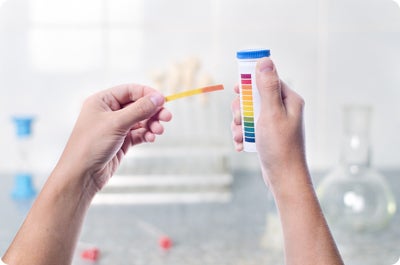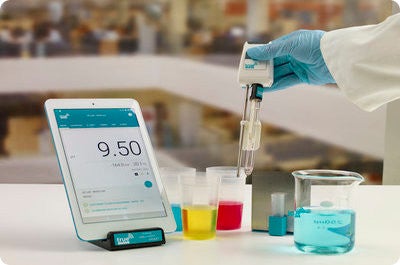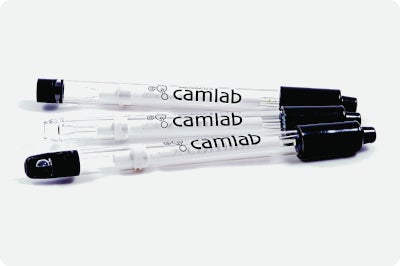When you're looking to buy a pH meter, whether it's to start measuring or to replace an existing meter, the range of brands and specifications available is huge. With so many options it can be difficult to know where to start, but taking a little time to choose carefully could save you a lot of time and money overall by making sure the meter you choose is right for you. [caption id="attac...
- Home
- Products
- Lab Equipment
- Meters for Measurement
- pH Meters
- Halo Bluetooth pH meter Glass probe

- £225.14 excl. VAT
- £270.17incl. VAT
- £321.63 excl. VAT
- £385.96incl. VAT
HALO is the world's first professional pH probe with Bluetooth® smart technology. It comprises a double junction refillable glass pH probe with built in temperature sensor for use virtually anywhere with a compatible device to receive the signal.
Can be used in the field, laboratory or classroom - the flexibility and ease of use offers a great new way to measure pH.
HALO features;
- Refillable glass pH electrode
- Double junction reference design
- Integrated temperature sensor
- Wide pH (0-13) and temperature (-5 to +80°C) range
- Data wirelessly transmits to an iPad running the Hanna Lab App via Bluetooth smart technology (10m range)
- One button sample tagging
- HALO stores calibration information - no additional calibration is needed if you switch to a new iPad or Edge Bluetooth meter
- 12mm outer diameter of the glass probe
- 195mm overall length
- Accuracy ±0.005 pH, ±0.3 mV, ±0.5°C (at 25°C)
- Up to 5 point calibration is possible with a choice of 7 standard buffers (1.68, 4.01, 6.86, 7.01, 9.18, 10.01, 12.45 pH)
- Automatic temperature compensation from -5 to 100°C
NB this Bluetooth electrode requires a compatible receiving device to receive the readings - either an iPad with the Hanna Lab App or the Edge Bluetooth meter
Hanna Lab App
The Hanna Lab App turns an iPad into a pH meter when used with the Hanna Halo pH electrode. Functions include calibration, measurement, data logging, graphing and data sharing. Measurement and logging of pH and temperature at one second intervals start as soon as the probe is connected. Measurements can be displayed alone on the display, with tabulated data, or as a graph. The graph can be planned and zoomed with the iPad's pinch-to-zoom technology for enhanced viewing.
Connecting a HALO probe to the Hanna Lab App is simple; tap the Bluetooth icon in the top right corner to view all available HALO probes, then press the button on your HALO probe. The blue halo on the probe will start blinking, indicating that it is in discovery mode. Select the newly discovered HALO probe from the list of available probes. If a previously associated probe is discoverable when the app is opened, it will connect to that probe automatically.
- Connects to HALO via Bluetooth 4.0
- Up to 5 point calibration with 7 standard buffers available
- Calibration reminder
- pH and temperature updated every second
- Basic and full GLP
- Fluid, dynamic graphing
- Measurement alarms to tell you if the measurement threshold is exceeded
- One button sample tagging
- Data logging with custom annotations
- Share data by email in CSV format
- Help and tutorials
Which pH meter/electrode do I need?...
Making sure you have the right electrode and meter for your application can be confusing, not to mention correct maintenance and what to do if you are having issues. You can find links to our support guides below to help you through the process.
If you are after an electrode selector guide for some of our most popular electrodes and what applications they are recommended for you can find that below.
|
|
||
|
An introduction to pH pH, put simply is a measure of how acidic or basic a solution is. It is a measure of H+ions present. pH can be measured in a number of ways including test strips, indicator solution or with a pH meter and electrode. If you want to read more about the pH and the pros and cons of these methods, you can check out our introduction guide here. |
How to take a pH reading and care for your electrode pH electrodes require the correct storage and regular calibration. If you have a pH meter or are looking to purchase and need to find out more about the care and maintenance process then you can read our guide here. We also include a troubleshoot sections with the most reported issues and possible solutions. |
Selecting the right electrode and meter for your application So you have decided you need to purchase a pH meter with electrode, but with such a wide selection out there, how do you know which is right for you? You can read our guide on the differences between electrodes and what applications different features are good for. We also have an electrode selection guide for some of our most popular electrodes. |
Related Products |
||
If you require any further assistance, or extra information you can request that here and one of our trained technical specialists will be in contact. Please provide as much detail as possible so that we can get back to you with the right information.
Servicing Options Available
Have you considered your servicing requirements? Much like a car, scientific instruments may need a bit of care to keep them working reliably and at their most accurate.
The Camlab Service Department have over 60 years experience in scientific instrumentation. We have a number of highly qualified internal and field-based service engineers able to perform a variety of jobs including preventative maintenance servicing and calibration.
Camlab can offer yearly service contracts which include two main types of preventative maintenance/calibration services – the back to base service and an engineer visit to your site. These options are can be offered with differing turn around times depending on the instrument type and your requirements along with loan instruments if available.
|
|
|
|
A typical preventative maintenance service includes the following: Inspection and testing of the unit
Dismantling, cleaning and inspection of the key parts
Correction of minor defects including adjustments if necessary
Reassembly and testing
Take post adjustment / cleaning readings
Supply of calibration certificate
Return of the item to you (back to base services)
|
|
Request a quote for your servicing requirements today.
| For more information on this product please click the Request information button below and we will get back to you as soon as we can. |
| Request information |
Alternatively, a consultation visit from one of our highly experienced product specialists is available for this range. Typically our specialist will be able to go through the following aspects with you to help you make the right choices and be able to deliver them on time and and on budget.
|
| Request Consultation |
| The links above will take you to our request information page which will forward your enquiry to our team. Please provide as much detail as possible so that we can get back to you with the right information. We normally aim to get back to you same day or within 24 hours on weekdays. If you enquiry is more urgent please call our support team on 01954 233 120 |










